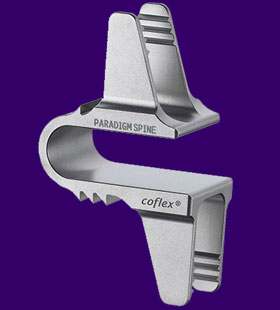
The Coflex implant is the innovative device used during Interlaminar Stabilization surgery after decompression treatment is performed for lumbar spinal stenosis. The device is manufactured by Paradigm Spine and was approved for the treatment of certain types of lumbar spinal canal narrowing by the FDA in 2012.
Coflex works on a very similar principle to the more famous X-Stop implant used during IPDS surgery. However, the X-Stop is an alternative to traditional invasive decompression surgery, while the Coflex is an addendum to traditional decompression techniques. Therefore, although the two devices work on extremely similar principles, the actual process involved in their utilization is completely different.
Coflex is primarily marketed as a means of avoiding spinal fusion surgery after traditional laminectomy or other variety of decompression surgery. The implant helps to stabilize the vertebral column, eliminating the need for the very worst part of the typical combined surgical cure for lumbar stenosis: spondylodesis.
This patient guide examines the clinical use, design and results of the Coflex spinal implant during Interlaminar Stabilization surgery following decompression of the lower lumbar nerve roots.
Coflex Implant Design
The Coflex implant device is a simple one piece design that fits in between the spinous processes in order to maintain the height of the vertebral bodies and preserve the patency of the spinal canal after decompression surgery. The implant allows the patient to avoid the traditional spinal fusion that is often used to create greater stability in the vertebral column following the damage caused by the decompression procedure.
Coflex has no moving parts and is constructed of durable titanium material for a life-time of use. The implant is placed on the posterior of the spine, outside the spinal canal, thereby not creating any additional risk of nerve damage or canal impingement due to the device itself.
Coflex is not utilized by itself, in the same manner as the X-Stop device. Instead, it is always utilized as an add-on procedure when spondylodesis would otherwise be required. In cases where fusion would not be needed following minimally-damaging decompression, the claimed benefits of Coflex might be far less apparent.
Coflex Implant Surgery
The Interlaminar Stabilization surgery is performed after lumbar nerve root decompression is finished and the spinal canal is restored to a functional patency. After decompression, the surgeon will create room for the Coflex in between the spinous processes at the previously operated level. The implant will be fitted into the space and will not require to be surgically attached to the bones in order to remain in position.
The benefits claimed by the manufacturer are all rated in comparison against traditional lumbar fusion surgery. These benefits include less blood loss, faster procedural time, shorter stay in the hospital postoperatively, quicker recuperation, faster and long-lasting symptomatic reduction, increased overall satisfaction and a more natural functionality in the operated levels of the spine.
Of course, the decompression procedure itself must be successful if the patient is to enjoy most of these benefits. If the spinal canal remains internally compromised, the Coflex implant is not meant to provide neurological decompression all by itself.
Coflex Outcomes
Coflex devices demonstrate good results when used as indicated. The treatment is certainly more enlightened than the fusion path, since Coflex allows movement of the spine and does not increase the degenerative effects on neighboring vertebral level in the same manner as spondylodesis does.
Therapy results are satisfactory and promising, but some patients still suffer complications and poor outcomes after combination decompression and Coflex spinal implantation surgery. Some of the possible explanations for this occurrence include any of the following factors:
Misdiagnosis is a common problem that can diminish the positive results of any treatment. If the stenosis is incidental and not causative for the painful complaint, Coflex will probably not provide many, if any, benefits, except by the power of the magnificent placebo, which is virtually always temporary.
If the decompression surgery fails to provide positive results, the Coflex will be far less effective. Continued spinal nerve root compression or scar tissue formation might be reasons for poor symptomatic reduction results and diminished satisfaction ratings.
Implant rejection, infection or migration can all spell big problems for patients and are some of the more commonly cited reasons for Coflex removal. Some patients suffer a variety of conditions involving slippage of the implant, continuing pain, recurrent infection or other device-related problem that may necessitate revision or removal operations.
Coflex-F Option
Coflex-F is a different medical implant device that looks very similar, but is used for a completely unique purpose. The Coflex-F is used when a traditional spinal fusion is actually performed at a single level, replacing the need for pedicle screw hardware reinforcement.
The implant itself is shaped the same as the normal Coflex, but is fastened to the fused vertebrae in an effort to encourage a strong, stable fusion and supplement the reinforcing interbody cage and bone graft.
The Coflex-F is not used instead of spondylodesis, but is actually an inherent part of the fusion procedure that minimizes healing time, reduces blood loss and decreases the time needed for the vertebrae to actually fuse solid.
For more information on the Coflex or Coflex-F spinal implant devices, or the Interlaminar Stabilization procedure, contact your spinal surgeon.





